#loss estimated
Text
The Democratic Republic of Congo (DRC) has been ravaged by a devastating genocide, resulting in the loss of an estimated 15 million lives. In the face of such immense tragedy, it is imperative that humanity does not remain insensitive to the suffering of the Congolese people. The genocide in the DRC has displace the lives of more than 7 million people, leaving behind a trail of unimaginable suffering. It is our collective responsibility as human beings to respond with compassion and action. Alph Lukau’s prayers for healing our land and stopping the genocide serve as a powerful reminder that humanity cannot be insensitive to the plight of others. In his sunday services the general overseer of AMI , Pastor Alph Lukau called upon all Africans to unite, raise voices, and work towards healing the land and bringing an end to the genocide, ensuring that such atrocities are never repeated. Pastor Alph Lukau, renowned for his spiritual guidance and powerful prayers, has dedicated himself to praying for the healing of countries, especially Ukraine, India, Mozambique and Zimbabwe. His prayers extend beyond physical healing, encompassing emotional and spiritual restoration for the Congolese people. Lukau’s prayers provide solace and hope to those affected by the genocide, reminding them that they are not alone in their struggle.
#pastor alph lukau#pastor lukau#alph lukau#ravaged#devastating genocide#loss estimated#15 million lives#immense tragedy#imperative#humanity sensive#suffering#congolese people#branding#2023#logo#ui#devastating#genocide#design#illustration#graphic design#vector#displaced the lives#7 million people#unimaginable suffering#collective responsibility#human beings#respond compassion#action#lukau praryer
0 notes
Text
Placements are legit cooked this season rn idk why
#why is it that all of my friends are getting predicted multiple ranks below who they’re playing against in placements#like a friend of mine in bronze was doing placements almost exclusively against plats#and a friend of mine can’t stop getting an estimated diamond 5 while playing against exclusively low masters and high diamond players.#she’s 1-6 on a 5 game loss streak and it won’t budge lmfao#like. blizzard what’s going on here#a kid (LITERAL kid. 15.) I’m helping got thrown into hell and so I’m helping him learn to reframe how he thinks so he can both improve and#claw his way out of bronze bc this kid is def high silver or low gold but is having a hard time playing like… with intent. something I#haven’t talked about here in ages. but the second he started taking my advice he started winning. hashtag Aunt Cee has logged in#c talks
2 notes
·
View notes
Note
is your cat ok? hoping for love and rest for all of you
Nah, we thought he'd just fallen and sustained an injury at first, but turns out it was a blood clot that resulted from a previously undetected heart murmur. Unfortunately, he had a stroke and had to be put down today. Thanks for the well wishes, though, they're appreciated
#truly this happened like a year and a week since we had to put our other cat down it's absurd#late feb/early march is so cursed#anon#asks#cw pet loss#if it's any consolation to us at least he was fairly elderly. he wasn't a spry young thing anymore you know?#he was estimated to be around 8-10 when we first found him so he had to be like....13-15? ish?#still it was very sudden just no warning at all
5 notes
·
View notes
Text

I left my house before 10 AM to make sure I was “on time” for a shift that starts at 1 PM.
I just arrived a little more than 2 hours later from what is supposed to be about a 45-minute commute — that is, when Chicago Transit isn’t mid-collapse.
So I’m going to read this book about Julian of Norwich for a minute before I start.
#also FMI (for mutuals’ information)#my left ear has not stopped ringing yet#(we’re at 24 hours without break at this point)#and I would estimate hearing loss in that ear to be at 80%#photo#photos
3 notes
·
View notes
Text
I choose to ignore the thing about River giving up all her remaining regenerations to save the doctor, there's not really any reason for it to be the case and it just doesn't sit right with me? It feels sort of unbalanced if that makes sense, like River literally giving up everything to some guy she just met
And it was established in the library episode that the Doctor wouldn't have survived what River did either, so they don't need it to explain why she didn't regenerate then
So I'll just ignore it
#doctor who#ive been thinking about this for a while#bc i saw someone recently saying it didnt seem right that Amy would just let river do that#and tbh i think you could explain her letting river doing that by her just kinda getting caught in the moment + not really understanding#the value of regeneration. humans are pretty bad at estimating value - especially of something they arent familiar with#its hard to be upset about the loss of something you didnt really understand#but its also easy to explain it as Amy didnt react bc it simply didnt happen 😌#dw#river song
10 notes
·
View notes
Text
Does anyone know at what age did kenshi lost his eyesight? In the snowblind movie he looked like he was in middle 20's mabey?
#i tried to look it up but doesnt really tell u anything#was his kid alreasy born when it happened? pretty sure he had the kid later on but im kinda new to the story so 🙃#if anyone could give me an answer#canon or a estimation perhaps?#mostly going for the snowblind movie#mortal kombat kenshi#kenshi takahashi#mortal kombat spoilers#mortal kombat#MK#mk#mortal kombat legends snow blind#mortal kombat snow blind spoilers#tw vision loss
18 notes
·
View notes
Text
twitter pretty much self imploded so here i am once again

#i give it about 6 months before elon tries to sell the bird app at a loss#and that’s a very conservative estimate#trio posts
5 notes
·
View notes
Text
I slept in and just woke up, so here's what I've been able to figure out while sipping coffee:
Twitter has officially rebranded to X just a day or two after the move was announced.
The official branding is that a tweet is now called "an X", for which there are too many jokes to make.
The official account is still @twitter because someone else owns @X and they didn't reclaim the username first.
The logo is 𝕏 which is the Unicode character Unicode U+1D54F so the logo cannot be copyrighted and it is highly likely that it cannot be protected as a trademark.
Outside the visual logo, the trademark for the use of the name "X" in social media is held by Meta/Facebook, while the trademark for "X" in finance/commerce is owned by Microsoft.
The rebranding has been stopped in Japan as the term "X Japan" is trademarked by the band X JAPAN.
Elon had workers taking down the "Twitter" name from the side of the building. He did not have any permits to do this. The building owner called the cops who stopped the crew midway through so the sign just says "er".
He still plans to call his streaming and media hosting branch of the company as "Xvideo". Nobody tell him.
This man wants you to give him control over all of your financial information.
Edit to add further developments:
Yes, this is all real. Check the notes and people have pictures. I understand the skepticism because it feels like a joke, but to the best of my knowledge, everything in the above is accurate.
Microsoft also owns the trademark on X for chatting and gaming because, y'know, X-box.
The logo came from a random podcaster who tweeted it at Musk.
The act of sending a tweet is now known as "Xeet". They even added a guide for how to Xeet.
The branding change is inconsistent. Some icons have changed, some have not, and the words "tweet" and "Twitter" are still all over the place on the site.
TweetDeck is currently unaffected and I hope it's because they forgot that it exists again. The complete negligence toward that tool and just leaving it the hell alone is the only thing that makes the site usable (and some of us are stuck on there for work).
This is likely because Musk was forced out of PayPal due to a failed credit line project and because he wanted to rename the site to "X-Paypal" and eventually just to "X".
This became a big deal behind the scenes as Musk paid over $1 million for the domain X.com and wanted to rebrand the company that already had the brand awareness people were using it as a verb to "pay online" (as in "I'll paypal you the money")
X.com is not currently owned by Musk. It is held by a domain registrar (I believe GoDaddy but I'm not entirely sure). Meaning as long as he's hung onto this idea of making X Corp a thing, he couldn't be arsed to pay the $15/year domain renewal.
Bloomberg estimates the rebranding wiped between $4 to $20 billion from the valuation of Twitter due to the loss of brand awareness.
The company was already worth less than half of the $44 billion Musk paid for it in the first place, meaning this may end up a worse deal than when Yahoo bought Tumblr.
One estimation (though this is with a grain of salt) said that Twitter is three months from defaulting on its loans taken out to buy the site. Those loans were secured with Tesla stock. Meaning the bank will seize that stock and, since it won't be enough to pay the debt (since it's worth around 50-75% of what it was at the time of the loan), they can start seizing personal assets of Elon Musk including the Twitter company itself and his interest in SpaceX.
Sesame Street's official accounts mocked the rebranding.
158K notes
·
View notes
Text
For Democrats to maintain Senate control, Senator Jon Tester (D-MT) needs to win reelection in a state Donald Trump won by 16.4 percentage points in 2020.
That brutal reality is reflective of the vicious Senate map Democrats were handed this year in a chamber already tilted against them. After Sen. Joe Manchin’s (D-WV) retirement, Republicans can confidently add that seat to their roster, bringing them to 50 senators, assuming they return their incumbents (whose losses would be major upsets). Tester’s loss would give them the majority.
If Tester wins, and Democrats win the White House and flip the House, that means a 2020-like environment with the possibility of major legislation and the certainty of judicial confirmations. If he does not, Congress would return to 2022’s legislative graveyard, now with a Republican Senate that would likely block many judicial confirmations and move to stop a President Kamala Harris from filling any Supreme Court vacancies that arise. If Republicans win the presidency and keep the House, of course, Democrats’ losing the Senate opens the door to a no-holds-barred, full-scale Trump agenda.
The perennial survivor, the last statewide Democrat in an increasingly MAGAfied Montana, has to turn in the political performance of a lifetime, and do something he’s never done before — overcome those headwinds in an election where Trump is on the ballot.
“Oh yes,” Mike Dennison, currently a political analyst and the former longtime chief political reporter at the Montana Television Network, said when TPM asked if Tester could win in these conditions. “Although it’ll probably be the most difficult test in his career.”
Tester is now a singular breed in the Senate, the last stronghold in a state that has, particularly in the past four years, completely repudiated his party. Sens. Sherrod Brown (D-OH) — also in the fight of his life — and Susan Collins (R-ME) have historically pulled off a similar feat, but still operate in more hospitable environments than Tester. In 2018, the other Tester-like incumbents in the Senate — Democrats Joe Donnelly in Indiana, Claire McCaskill in Missouri, Heidi Heitkamp in North Dakota — got wiped out, presaging the death of ticket-splitting among an increasingly polarized electorate. Tester hung on by 3.6 points.
Now, Tester finds himself in a curious moment. President Joe Biden, whose drag Tester felt acutely enough to publicly beseech him to leave the race, has done so. Democrats have a new nominee in Vice President Kamala Harris, bringing with her an exuberant and newly generous voting base.
Experts have told TPM that an energized Democratic base can only help Tester and Brown, that a rising tide lifts all boats, that any factor lessening the number of Trump voters they have to win over is a boon. But Tester hasn’t exactly been acting like it. He declined to endorse a candidate for president and thus far, per experts in the state, has maintained his strategy of keeping his party at arm’s length.
“If he continues here with the anti-Biden perspective, which tangentially impacts Harris as well, that would hurt him longterm,” said Paul Pope, a political scientist at Montana State University Billings.
“I don’t understand why Tester isn’t saying, ‘look, here are things Democrats have done that are good for Montana: the COVID relief bill, the infrastructure bill, advancing green energy,’” Dennison said, framing the hypothetical argument as “hey, maybe you don’t like Democrats, but here’s some things they’ve done that I’ve voted for that are good for the state.”
When he posed that question to the politically keyed-in in the state, some have offered that the Democratic brand is “so damaged” in Montana that it’s best for Tester to abandon it altogether.
Instead, Tester has tried to keep the race hyper-local, focusing on issues like public land rights and downplaying that his victory would likely seal Democratic control of the upper chamber.
Polling in the state has been scarce, and much of what has been released comes from partisan pollsters. A recent poll paid for by KULR-TV in Billings had Republican Tim Sheehy up six points; an Emerson poll put into the field a few days before had him up two. Dennison told TPM he’s seen a private poll of 6,000 people from the last couple weeks that had Tester up one.
It’s a testament to Tester’s talent that election projectors including the Cook Political Report and the University of Virginia’s Sabato’s Crystal ball have his race in the “tossup” category.
“Recent historical trends suggest both of them to lose,” Kyle Kondik, managing editor of Sabato’s Crystal Ball, told TPM of Tester and Brown in a recent interview. “That’s not a prediction — it’s just what history tells us. Just because ticket-splitting has been on the decline for a while doesn’t mean it has to continue to.”
Some onus will fall to Harris to stem the bleeding. There’s no question that she’ll lose Montana, but she needs to keep the margins low enough that Tester can overcome the delta. The recent KULR-TV poll showed her down 14 points, improving on Biden’s 2020 margin; Dennison estimated that if she can keep her loss in the neighborhood of 12-14 points, it would give Tester a fighting chance.
Harris’ entry isn’t the only factor that could shake up Tester’s race. Last Tuesday, the Montana secretary of state’s office certified a constitutional amendment to protect abortion rights, which will appear on the ballot in November. Abortion rights are popular in Montana, which currently protects the procedure until viability.
“Everything looks like the abortion ballot measure to protect reproductive rights is most likely to pass,” Pope said.
The presence of the amendment also won’t guarantee Tester’s path to victory; in other red states, voters have consistently demonstrated their comfort with the cognitive dissonance of voting for abortion rights and Republican lawmakers who oppose them on the same ballot.
Tester’s opponent, political newcomer Sheehy called abortion “sinful,” saying last December at a Fulton County Republican Women open house, “I think it’s terrible. I think it’s a repulsive thing to do,” per the Heartland Signal, the newsroom for progressive, Illinois-based radio station WCPT820. He also said that he wants it “all to end tomorrow.”
Still, to the extent that the initiative — like Harris’ candidacy — energizes Tester-friendly voters and motivates them to turn out, it can’t hurt.
“It can only help Tester — I don’t know how much, but I think it’s to his benefit,” Dennison said. “It’s going to draw more Democratic-leaning voters to the polls and more women to the polls, who are more supportive of Tester.”
#Jon Tester#US 2024 Elections#US Senate#Tester has tried to keep the race hyper-local#focusing on issues like public land rights and downplaying that his victory would likely seal Democratic control of the upper chamber#Everything looks like the abortion ballot measure to protect reproductive rights is most likely to pass#Dennison estimated that if she can keep her loss in the neighborhood of 12-14 points#it would give Tester a fighting chance
0 notes
Text
(MENAFN- EIN PRNewswire)
STOP THE GENOCIDE
Pastor Alph Lukau called upon all Africans to unite, raise voices, and work towards healing the land and bringing an end to the Genocide in Congo. I appeal all governments and call upon all Africans to unite, raise voices, and work towards healing the land and bringing an end to the Genocide in Congo immediately.” - Pastor Alph Lukau JOHANESSBURG , KELVIN VIEW, SOUTH AFRICA, February 11, 2024 /EIN PRNewswire / -- The Democratic Republic of Congo (DRC) has been ravaged by a devastating genocide, resulting in the loss of an estimated 15 million lives. In the face of such immense tragedy, it is imperative that humanity does not remain insensitive to the suffering of the Congolese people. Pastor Alph Lukau has emerged as a beacon of hope, offering prayers for healing and actively working towards putting an end to the genocide. This stand taken by Pastor Alph Lukau delves into the urgent need to heal our land , stop the genocide, and appeals the Governments the importance of addressing this humanitarian crisis with compassion and action.
#Pastor Alph Lukau#Africans#Unite#Raise Voice#Work Towards#Healing Land#Bring End#Congo#Appeal Governments#Call#stop genocide#Congo democratic republic#ravaged#devastating loss#estimated#15 million lives#immense tragedy#humanity sensitive#Congolese
0 notes
Text
"A century of gradual reforestation across the American East and Southeast has kept the region cooler than it otherwise would have become, a new study shows.
The pioneering study of progress shows how the last 25 years of accelerated reforestation around the world might significantly pay off in the second half of the 21st century.
Using a variety of calculative methods and estimations based on satellite and temperature data from weather stations, the authors determined that forests in the eastern United States cool the land surface by 1.8 – 3.6°F annually compared to nearby grasslands and croplands, with the strongest effect seen in summer, when cooling amounts to 3.6 – 9°F.
The younger the forest, the more this cooling effect was detected, with forest trees between 20 and 40 years old offering the coolest temperatures underneath.
“The reforestation has been remarkable and we have shown this has translated into the surrounding air temperature,” Mallory Barnes, an environmental scientist at Indiana University who led the research, told The Guardian.
“Moving forward, we need to think about tree planting not just as a way to absorb carbon dioxide but also the cooling effects in adapting for climate change, to help cities be resilient against these very hot temperatures.”
The cooling of the land surface affected the air near ground level as well, with a stepwise reduction in heat linked to reductions in near-surface air temps.
“Analyses of historical land cover and air temperature trends showed that the cooling benefits of reforestation extend across the landscape,” the authors write. “Locations surrounded by reforestation were up to 1.8°F cooler than neighboring locations that did not undergo land cover change, and areas dominated by regrowing forests were associated with cooling temperature trends in much of the Eastern United States.”
By the 1930s, forest cover loss in the eastern states like the Carolinas and Mississippi had stopped, as the descendants of European settlers moved in greater and greater numbers into cities and marginal agricultural land was abandoned.
The Civilian Conservation Corps undertook large replanting efforts of forests that had been cleared, and this is believed to be what is causing the lower average temperatures observed in the study data.
However, the authors note that other causes, like more sophisticated crop irrigation and increases in airborne pollutants that block incoming sunlight, may have also contributed to the lowering of temperatures over time. They also note that tree planting might not always produce this effect, such as in the boreal zone where increases in trees are linked with increases in humidity that way raise average temperatures."
-via Good News Network, February 20, 2024
#trees#forests#reforestation#tree planting#global warming#climate change#climate crisis#american south#the south#eastern us#southern usa#conservation#meteorology#global temperature#conservation news#climate news#environment#hope#good news#hope posting#climate action#climate science#climate catastrophe#climate hope
14K notes
·
View notes
Text
DONATE PLEASE NOT ONLY SHARE
Hello, my name is Hamza Al-Absi, a 32-year-old from Gaza.
I am a husband and a father of three children. Well, there were three, but I lost my eldest son, Osama, two years ago to leukemia (blood cancer). He deserved treatment for a year and a half, took his chemotherapy, fought the disease, and had a recovery period, but the disease returned, he had a strong relapse, and passed away. I couldn’t treat him again due to the blockade imposed on the Gaza Strip, which even affected patients with urgent, serious conditions. They refused to treat him, and he died in the hands of his mother and beside his younger brother, Saif. My son could have been treated, but when his turn came to get the treatment, it was too late.
I cannot express the pain of losing an eldest son, and my wife still cries for him every day. It’s a continuous pain that never leaves us.

Since the beginning of the war, we have heard news of children being killed and seriously injured by the insane and savage bombing with rockets and shells, which has not stopped since the war began until today. But thank God, my wife and I and our dear children, “Saif, 3 years old,” and “Rita, one year old,” are still alive.

We were forced to evacuate our home at the beginning of the war against our will due to the intense bombing that our area was subjected to and the orders to evacuate the area and head to southern Gaza. Our house was bombed with war shells, leading to its destruction.

Our journey of displacement began, moving several times from one area to another, until we ended up in a tent in the “Tel al-Sultan” area in the city of “Rafah.” You can imagine how difficult life is in a tent. Everything is done with great difficulty; we are forced to use primitive methods to carry out daily tasks. Every day we light a fire to prepare food, and we struggle to provide water for drinking or bathing. Going to the bathroom is a suffering in itself for adults before children, in the absence of toilets suitable for human use.

The situation worsens with the arrival of summer and the rise in temperatures; the tent literally turns into a “sauna” during the day, especially since my little daughter Rita has started walking on the sand and suffers from pollution diseases, influenza, and other serious diseases that lead to hepatitis.
On top of all that, I lost my job at the beginning of the war and became unemployed due to the total power outage and the lack of internet connection most of the time. I face severe difficulty in providing for my family’s needs amid the crazy price hikes.
We have suffered enough and have been exposed to a lot of fear and panic in the past 7 months. The city of “Rafah” is now threatened with a ground invasion at any moment by the occupation, so I decided to travel and leave Gaza to save the lives of my wife and children.
Time is running out, and we need $15,000 to enable my wife and children to leave Gaza to Egypt via the Rafah land crossing as soon as possible, in addition to the costs of staying in Egypt for 6 months, estimated at ($6,000).
Asking for help is not easy at all, but we believe there is still good in this world. So, I hope you will help us save ourselves from killing and destruction and restore hope to our lives again. I have tasted the bitterness of loss once, and I do not want to taste it again.
We are grateful to everyone who will donate to us, and we appreciate your feelings and support for us.
Verified by @nabulsi @90-ghost
@sayruq @el-shab-hussein
Verified number 226
#gaza#free palestine#free#free gaza#palestine#genocide#save palestine#palestinian genocide#from the river to the sea#fuck israel
7K notes
·
View notes
Text
Surprising New Research Links Infant Mortality to Crashing Bat Populations. (New York Times)
Excerpt from this New York Times story:
The connections are commonsense but the conclusion is shocking.
Bats eat insects. When a fatal disease hit bats, farmers used more pesticides to protect crops. And that, according to a new study, led to an increase in infant mortality.
According to the research, published Thursday in the journal Science, farmers in affected U.S. counties increased their use of insecticides by 31 percent when bat populations declined. In those places, infant mortality rose by an estimated 8 percent.
“It’s a seminal piece,” said Carmen Messerlian, a reproductive epidemiologist at Harvard who was not involved with the research. “I actually think it’s groundbreaking.”
The new study tested various alternatives to see if something else could have driven the increase: Unemployment or drug overdoses, for example. Nothing else was found to cause it.
Dr. Messerlian, who studies how the environment affects fertility, pregnancy and child health, said a growing body of research is showing health effects from toxic chemicals in our environment, even if scientists can’t put their fingers on the causal links.
“If we were to reduce the population-level exposure today, we would save lives,” she said. “It’s as easy as that.”
The new study is the latest to find dire consequences for humans when ecosystems are thrown out of balance. Recent research by the same author, Eyal Frank, an environmental economist at the University of Chicago, found that a die-off of vultures in India had led to half a million excess human deaths as rotting livestock carcasses polluted water and spurred an increase in feral dogs, spreading waterborne diseases and rabies.
“We often pay a lot of attention to global extinctions, where species completely disappear,” Dr. Frank said. “But we start experiencing loss and damages well before that.”
5K notes
·
View notes
Text
What does life in North Korea look like outside of Pyongyang? 🇰🇵
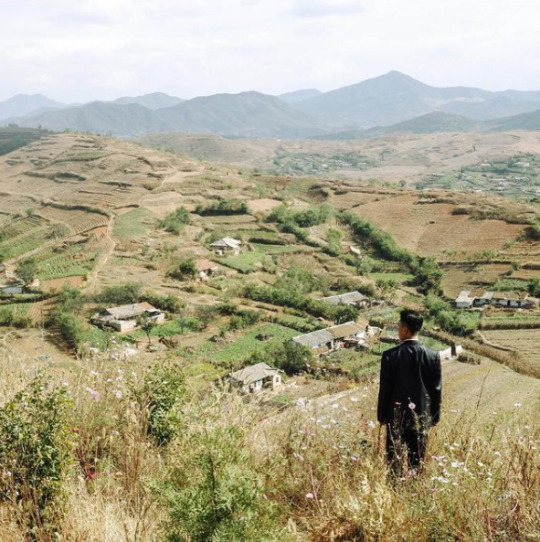
Hey, I'm back again with a very scary "tankie" post that asks you to think of North Koreans as people, and to consider their country not as a cartoonish dystopia, but as a nation that, like any other place on earth, has culture, traditions, and history.
Below is a collection of pictures from various cities and places in North Korea, along with a brief dive into some of the historical events that informs life in the so-called "hermit kingdom."
Warning: very long post
Kaesong, the historic city
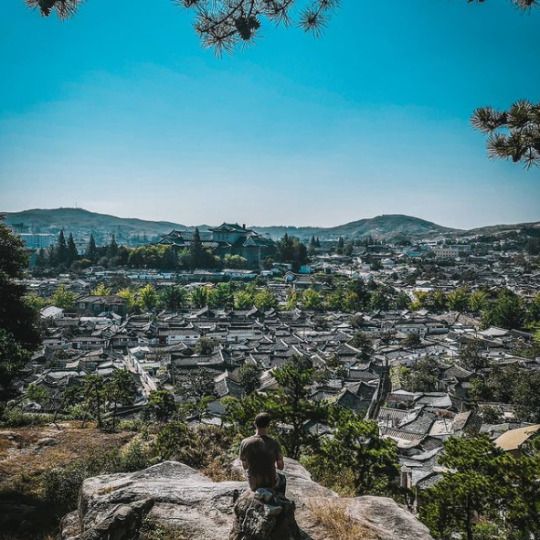
Beginning this post with Kaesong, one of the oldest cities in Korea. It's also one of the few major cities in the DPRK (i.e. "North Korea") that was not completely destroyed during the Korean war.
Every single city you'll see from this point on were victims of intense aerial bombardments from the U.S. and its allies, and had to be either partially or completely rebuilt after the war.
From 1951 to 1953, during what has now become known as the "forgotten war" in the West, the U.S. dropped 635,000 tons of bombs over Korea — most of it in the North, and on civilian population centers. An additional 32,000 tons of napalm was also deployed, engulfing whole cities in fire and inflicting people with horrific burns:
For such a simple thing to make, napalm had horrific human consequences. A bit of liquid fire, a sort of jellied gasoline, napalm clung to human skin on contact and melted off the flesh. Witnesses to napalm's impact described eyelids so burned they could not be shut and flesh that looked like "swollen, raw meat." - PBS
Ever wondered why North Koreans seem to hate the U.S so much? Well...
Keep in mind that only a few years prior to this, the U.S. had, as the first and only country in the world, used the atomic bomb as a weapon of war. Consider, too, the proximity between Japan and Korea — both geographically and as an "Other" in the Western imagination.
As the war dragged on, and it became clear the U.S. and its allies would not "win" in any conventional sense, the fear that the U.S. would resort to nuclear weapons again loomed large, adding another frightening dimension to the war that can probably go a long way in explaining the DPRK's later obsession with acquiring their own nuclear bomb.
But even without the use of nuclear weapons, the indiscriminate attack on civilians, particularly from U.S. saturation bombings, was still horrific:
"The number of Korean dead, injured or missing by war’s end approached three million, ten percent of the overall population. The majority of those killed were in the North, which had half of the population of the South; although the DPRK does not have official figures, possibly twelve to fifteen percent of the population was killed in the war, a figure close to or surpassing the proportion of Soviet citizens killed in World War II" - Charles K. Armstrong
On top of the loss of life, there's also the material damage. By the end of the war, the U.S. Air Force had, by its own estimations, destroyed somewhere around 85% of all buildings in the DPRK, leaving most cities in complete ruin. There are even stories of U.S. bombers dropping their loads into the ocean because they couldn't find any visible targets to bomb.
What you'll see below of Kaesong, then, provides both a rare glimpse of what life in North Korea looked like before the war, and a reminder of what was destroyed.

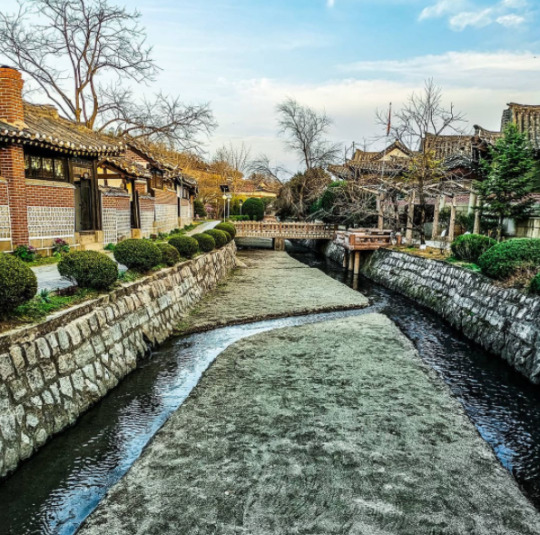

Kaesong's main street, pictured below.
Due the stifling sanctions imposed on the DPRK—which has, in various forms and intensities, been in effect since the 1950s—car ownership is still low throughout the country, with most people getting around either by walking or biking, or by bus or train for longer distances.
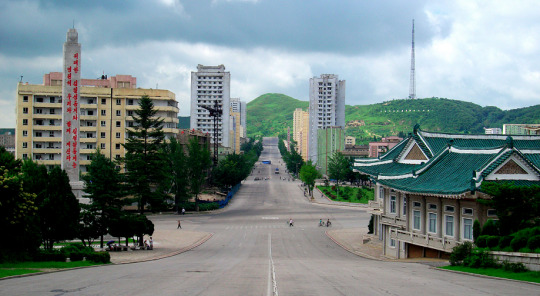
Kaesong, which is regarded as an educational center, is also notable for its many Koryŏ-era monuments. A group of twelve such sites were granted UNESCO world heritage status in 2013.
Included is the Hyonjongnung Royal Tomb, a 14th-century mausoleum located just outside the city of Kaesong.
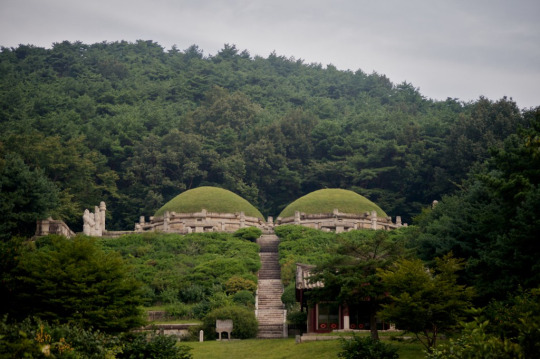
One of the statues guarding the tomb.
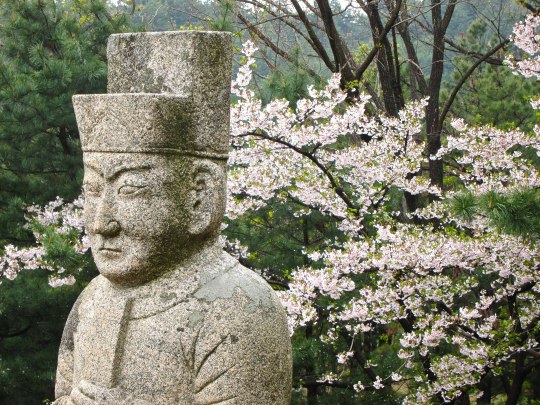
Before moving on the other cities, I also wanted to showcase one more of the DPRK's historical sites: Pohyonsa, a thousand-year-old Buddhist temple complex located in the Myohyang Mountains.

Like many of DPRK's historic sites, the temple complex suffered extensive damage during the Korean war, with the U.S. led bombings destroying over half of its 24 pre-war buildings.
The complex has since been restored and is in use today both as a residence for Buddhist monks, and as a historic site open to visitors.


Hamhung, the second largest city in the DPRK.
A coastal city located in the South Hamgyŏng Province. It has long served as a major industrial hub in the DPRK, and has one of the largest and busiest ports in the country.
Hamhung, like most of the coastal cities in the DPRK, was hit particularly hard during the war. Through relentless aerial bombardments, the US and its allies destroyed somewhere around 80-90% percent of all buildings, roads, and other infrastructure in the city.
Now, more than seventy years later, unexploded bombs, mortars and pieces of live ammunition are still being unearthed by the thousands in the area. As recently as 2016, one of North Korea's bomb squads—there's one in every province, faced with the same cleanup task—retrieved 370 unexploded mortar rounds... from an elementary school playground.
Experts in the DPRK estimate it will probably take over a hundred years to clean up all the unexploded ordnance—and that's just in and around Hamhung.
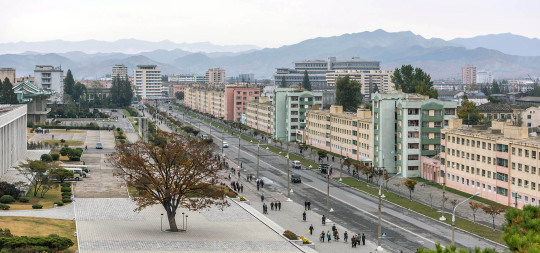

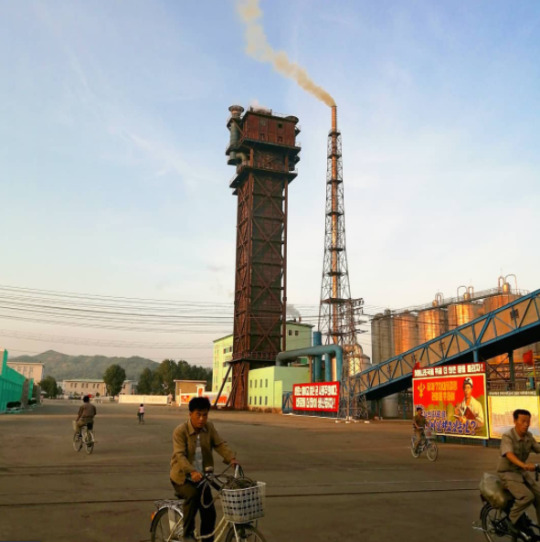
Hamhung's fertilizer plant, the biggest in North Korea.
When the war broke out, Hamhung was home to the largest nitrogen fertilizer plant in Asia. Since its product could be used in the creation of explosives, the existence of the plant is considered to have made Hamhung a target for U.S. aggression (though it's worth repeating that the U.S. carried out saturation bombings of most population centers in the country, irrespective of any so-called 'military value').
The plant was immediately rebuilt after the war, and—beyond its practical use—serves now as a monument of resistance to U.S. imperialism, and as a functional and symbolic site of self-reliance.

Chongjin, the third largest city in the DPRK.
Another coastal city and industrial hub. It underwent a massive development prior to the Korean war, housing around 300,000 people by the time the war broke out.
By 1953, the U.S. had destroyed most of Chongjin's industry, bombed its harbors, and killed one third of the population.
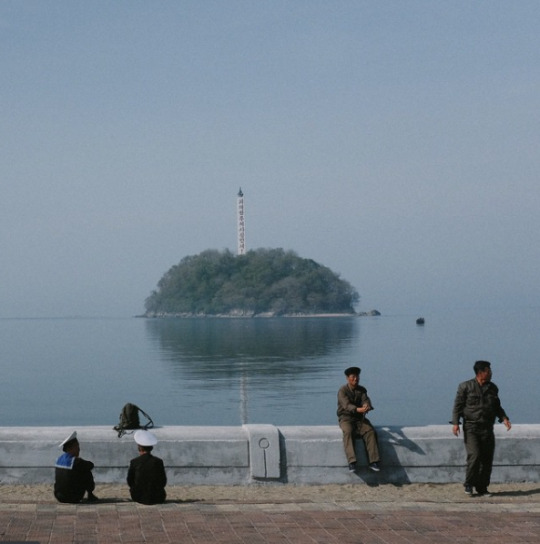
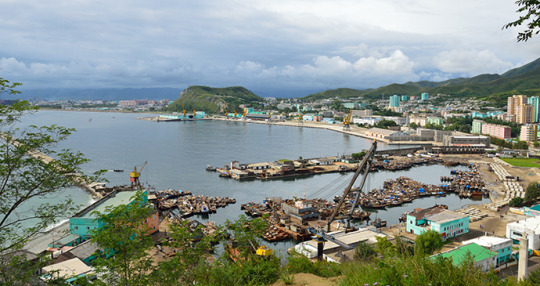

Wonsan, a rebuilt seaside city.
The city of Wonsan is a vital link between the DPRK's east and west coasts, and acts today as both a popular holiday destination for North Koreans, and as a central location for the country's growing tourism industry.
Considered a strategically important location during the war, Wonsan is notable for having endured one of the longest naval blockades in modern history, lasting a total of 861 days.
By the end of the war, the U.S. estimated that they had destroyed around 80% of the city.
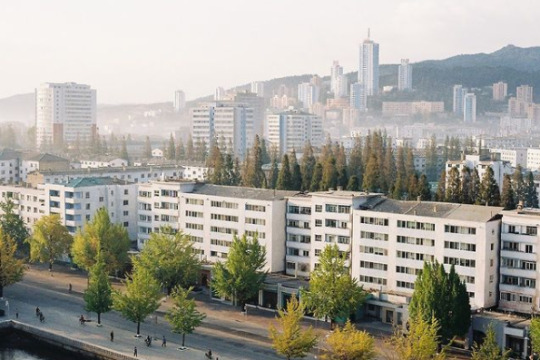

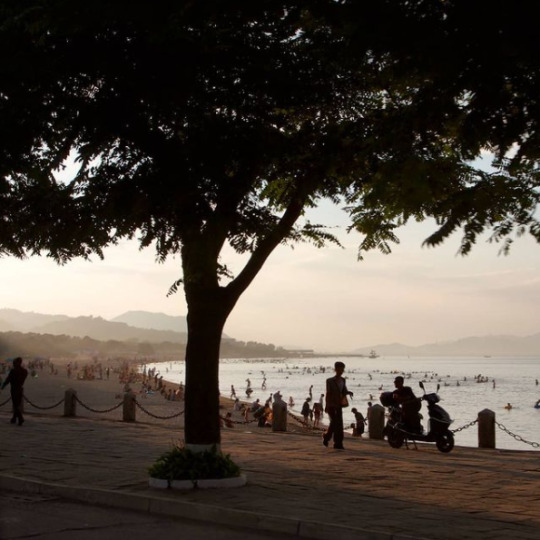

Masikryong Ski Resort, located close to Wonsan. It opened to the public in 2014 and is the first, I believe, that was built with foreign tourists in mind.
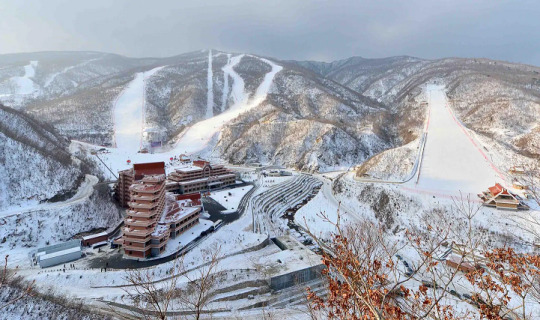
Sariwon, another rebuilt city
One of the worst hit cities during the Korean War, with an estimated destruction level of 95%.
I've written about its Wikipedia page here before, which used to mockingly describe its 'folk customs street'—a project built to preserve old Korean traditions and customs—as an "inaccurate romanticized recreation of an ancient Korean street."
No mention, of course, of the destruction caused by the US-led aerial bombings, or any historical context at all that could possibly even hint at why the preservation of old traditions might be particularly important for the city.
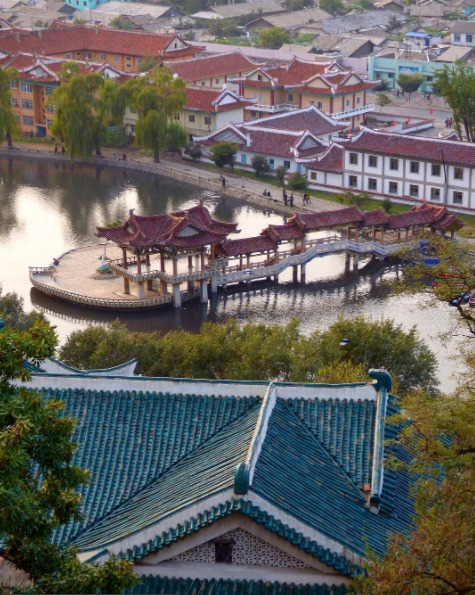

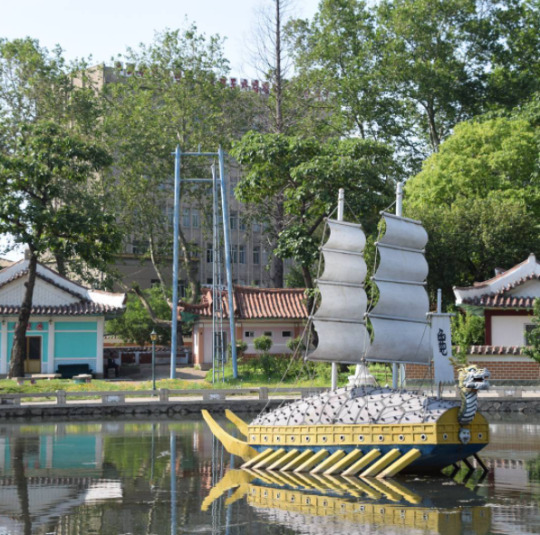
Life outside of the towns and cities
In the rural parts of the DPRK, life primarily revolves around agriculture. As the sanctions they're under make it difficult to acquire fuel, farming in the DPRK relies heavily on manual labour, which again, to avoid food shortages, requires that a large portion of the labour force resides in the countryside.
Unlike what many may think, the reliance on manual labour in farming is a relatively "new" development. Up until the crisis of the 1990s, the DPRK was a highly industrialized nation, with a modernized agricultural system and a high urbanization rate. But, as the access to cheap fuel from the USSR and China disappeared, and the sanctions placed upon them by Western nations heavily restricted their ability to import fuel from other sources, having a fuel-dependent agricultural industry became a recipe for disaster, and required an immediate and brutal restructuring.
For a more detailed breakdown of what lead to the crisis in the 90s, and how it reshaped the DPRKs approach to agriculture, check out this article by Zhun Xu.

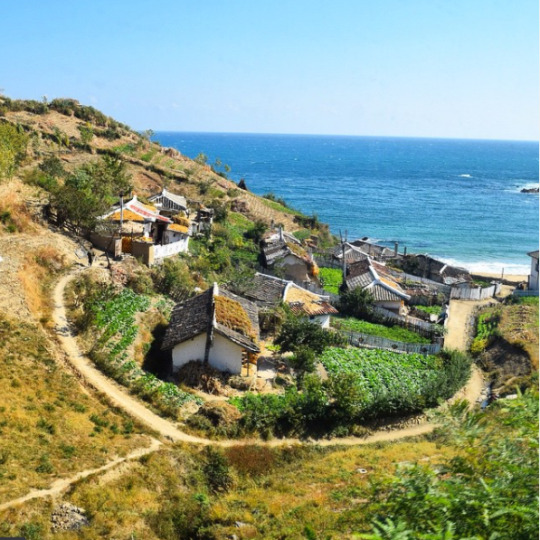
Some typical newly built rural housing, surrounded by farmland.
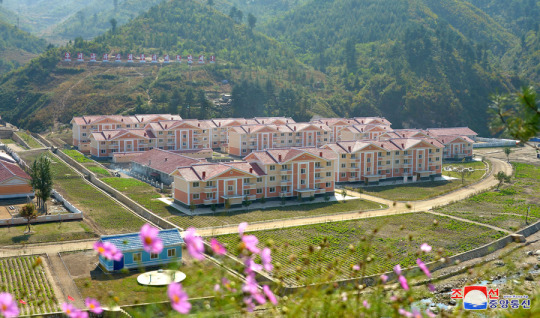
Tumblr only allows 20 pictures per post, but if you want to see more pictures of life outside Pyongyang, check out this imgur album.
#dprk#north korea#i've had this post unfinished in drafts for almost a year#also sorry about the spelling and potential formatting issues it's a nightmare to edit at this point#it was literally just meant to be a collection of picture and then the writing just sort of happened#enjoy the brief heritageposts history lesson i guess
6K notes
·
View notes
Text
#scored 1 for deductive reasoning#if only I can find my tweet or blog that had estimated russian losses greater than 300k back around November 2022#taiwantalk#ukraine#russia
1 note
·
View note
Text
I got bored so here's a movie chart
I went to the List of biggest box-office bombs wikipedia article and put all the data into an excel sheet. I simplified the data by taking the highest estimates anytime there were ranges of estimated loss/budget. Then I made a neat little chart.

On the left axis you have the amount lost in millions, adjusted for inflation. Each dot represents a film and is placed at the year it came out.
So! What does this tell us?
This tells us that, even accounting for inflation, box office failures have been more and more expensive and more and more frequent. Which means two things - films are getting more and more expensive as are their failures... but also, those failures are no longer enough to kill studios.
It used to be that even a major production studio could risk dying out from one or two big budget bombs. It is no longer the case. A lot of the later ones, the second half of the 2010s and the 2020s, are Disney productions.
In fact! out of the 25 films on this list that came out in the 2020s, 15 are Disney or 20th Century productions (20th being owned by Disney). That's completely ridiculous. Those films all have budgets of 150 million dollars at least. They all lost at least 100 million dollars. And that is not accounting for the marketing budget of the films - it is generally accepted that a modern film's real budget is double its production cost, because studios will spend around the same amount marketing the film as they do making it.
The fact that Disney productions is not currently reduced to ashes is complete nonsense.
And that, dear readers, is what monopolies do for you. That is what "too big to fail" means. It doesn't mean too big to encounter failure... It means too big for any failure to really affect you.
2K notes
·
View notes